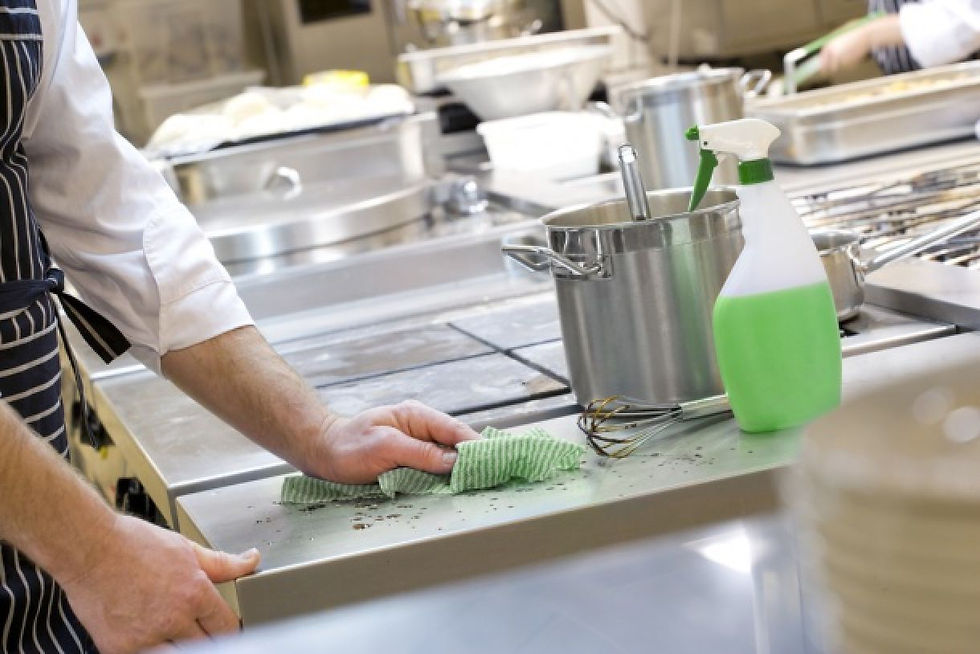The use of cleaning chemicals to maintain hygiene in kitchens
- Safic

- May 6, 2024
- 2 min read
Using chemicals to clean and sanitize kitchen surfaces is an effective way to maintain hygiene and ensure food safety. However, it's important to use these chemicals correctly to avoid contaminating food and to ensure they are effective in eliminating harmful bacteria and other pathogens. Here’s a guide on how to safely and effectively use cleaning chemicals in the kitchen:

1. Choose the Right Chemicals
Cleaning Agents: These are used to remove dirt, grease, and debris. Common cleaning agents include dish soap, degreasers, and all-purpose cleaners.
Sanitizers: These are used after cleaning to reduce the number of bacteria to safe levels. Common sanitizers include solutions containing bleach (sodium hypochlorite), quaternary ammonium compounds, and hydrogen peroxide.
2. Read Labels Carefully
Always read the product labels for proper usage instructions and safety warnings. Labels will provide information on dilution ratios, contact time (how long the surface must remain wet with the sanitizer), and specific instructions for food contact surfaces.
3. Dilution and Preparation
Prepare cleaning and sanitizing solutions according to the manufacturer's instructions. Incorrect dilution can render a solution ineffective or potentially dangerous.
4. Proper Cleaning Technique
Remove debris and food scraps from surfaces before applying cleaning agents.
Apply the cleaning agent and use a sponge, cloth, or brush to scrub surfaces thoroughly.
Rinse with clean water to remove any residual cleaning agents.
5. Sanitizing Process
After cleaning, apply the sanitizer. Ensure that the solution makes contact with all surfaces.
Allow the sanitizer to sit on the surface for the required contact time as specified by the manufacturer to effectively kill germs.
Some sanitizers require rinsing with water after the contact time, while others (like some food-safe sanitizers) can air dry.
6. Safety Precautions
Wear gloves and other protective gear if recommended by the product label to protect your skin and eyes.
Ensure the kitchen is well-ventilated when using strong chemicals to avoid inhaling fumes.
Never mix cleaning agents, especially chlorine bleach and ammonia, as this can produce dangerous gases.
7. Regular Maintenance
Clean and sanitize frequently touched surfaces regularly, such as countertops, appliance handles, and cutting boards.
Perform a deeper clean periodically to address areas that are not part of the daily routine.
8. Storage of Chemicals
Store cleaning chemicals in a secure place away from food items and out of reach of children and pets.
Keep chemicals in their original containers with labels intact.
9. Disposal
Dispose of chemicals and their containers according to local regulations. Never pour chemicals down the drain without knowing if it's safe to do so.
10. Training and Awareness
Safic provides the necessary training to make sure all employees are trained on the correct use of chemicals and understand the importance of following the guidelines.
By adhering to these guidelines, you can effectively use chemicals to maintain a hygienic kitchen environment, minimizing the risk of foodborne illnesses and creating a safer space for food preparation.
Safic can assist in assessing what chemicals should be use in any kitchen environments. Contact us on: 011 406 4000 or sales@safic.co.za for a sales representative to do the assessment and demonstrations on site.








Comments